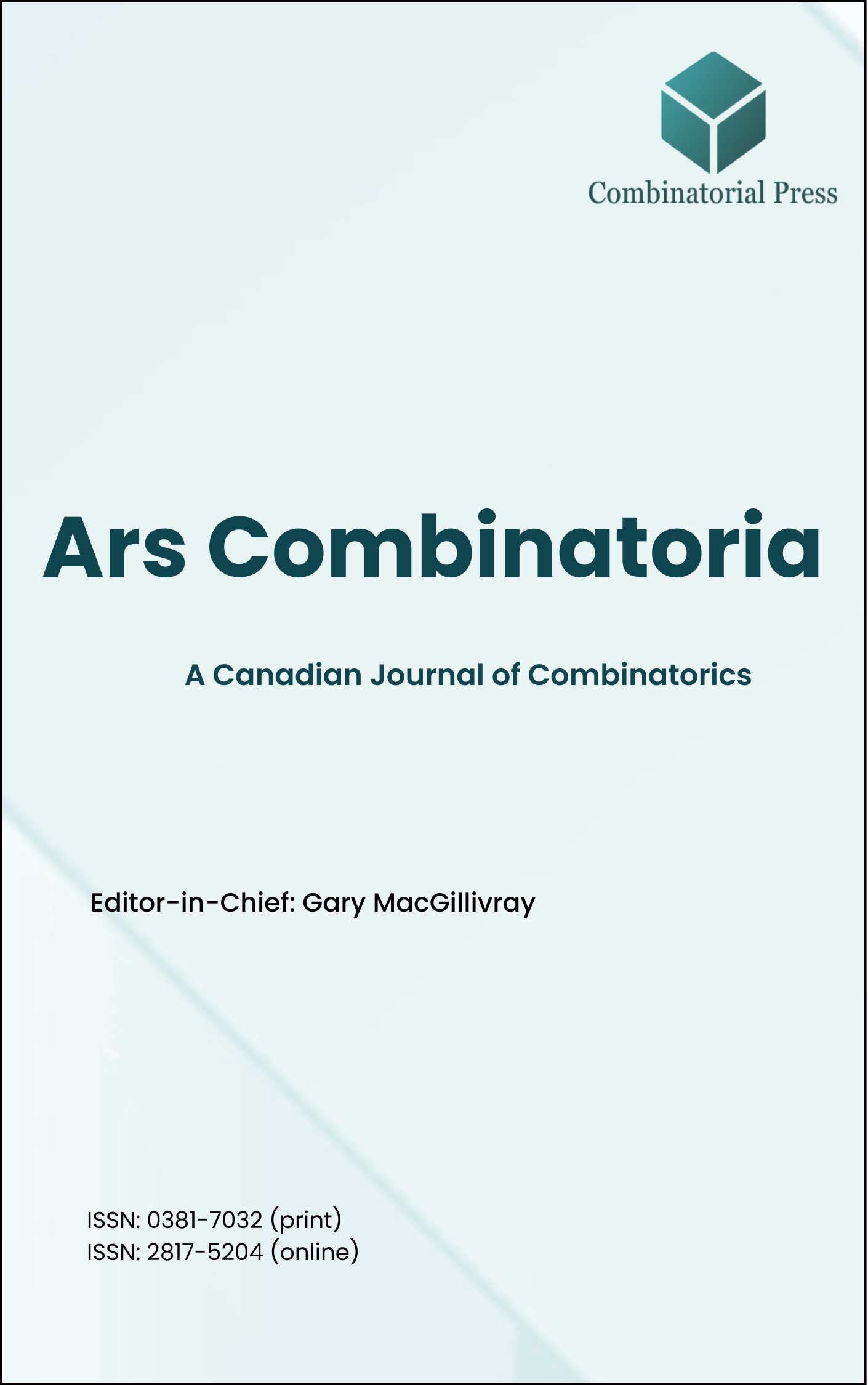
Ars Combinatoria
ISSN 0381-7032 (print), 2817-5204 (online)
Ars Combinatoria is the oldest Canadian Journal of Combinatorics, established in 1976. The journal is dedicated to advancing the field of combinatorial mathematics through the publication of high-quality research papers. From 2024 onward, it publishes four volumes per year in March, June, September and December. Ars Combinatoria has gained recognition and visibility in the academic community and is indexed in renowned databases such as MathSciNet, Zentralblatt, and Scopus. The Scope of the journal includes Graph theory, Design theory, Extremal combinatorics, Enumeration, Algebraic combinatorics, Combinatorial optimization, Ramsey theory, Automorphism groups, Coding theory, Finite geometries, Chemical graph theory but not limited.
Information Menu
- Research article
- Full Text
- Ars Combinatoria
- Volume 044
- Pages: 33-54
- Published: 31/12/1996
We study four \(q\)-series. Each of which is interpreted combinatorially in three different ways. This results in four new classes of infinite \(3\)-way partition identities. In some particular cases we get even \(4\)-way partition identities. Our every \(3\)-way identity gives us three Roderick-Ramanujan type identities and \(4\)-way identity gives six. Several partition identities due to Gordon \((1965)\), Hirschhorn \((1979)\), Subbarao \((1985)\), Blecksmith et al. \((1985)\), Agarwal \((1988)\) and Subbarao and Agarwal (1988) are obtained as particular cases of our general theorems.
- Research article
- Full Text
- Ars Combinatoria
- Volume 044
- Pages: 23-32
- Published: 31/12/1996
Motivated by the spectral radius of a graph, we introduce the notion of numerical radius for multigraphs and directed multigraphs, and it is proved that, unlike the spectral radius, the numerical radius is invariant under changes in the orientation of a directed multigraph. An analogue of the Perron-Frobenius theorem is given for the numerical radius of a matrix with nonnegative entries.
- Research article
- Full Text
- Ars Combinatoria
- Volume 044
- Pages: 3-22
- Published: 31/12/1996
We consider the polytope \(\mathcal{P}(s)\) of generalized tournament matrices with score vector \(s\). For the case that \(s\) has integer entries, we find the extreme points of \(\mathcal{P}(s)\) and discuss the graph-theoretic structure of its \(1\)-skeleton.
- Research article
- Full Text
- Ars Combinatoria
- Volume 043
- Pages: 272-286
- Published: 31/08/1996
Our purpose is to determine the minimum integer \(f_i(m)\) (\(g_i(m)\), \(h_i(m)\) respectively) for every natural \(m\), such that every digraph \(D\), \(f_i(m)\)-connected, (\(g_i(m)\), \(h_i(m)\)-connected respectively) and \(\alpha^i(D) \leq m\) is hamiltonian (D has a hamilton path, D is hamilton connected respectively), (\(i = 0,1, 2\)). We give exact values of \(f_i(m)\) and \(g_i(m)\) for some particular values of \(m\). We show the existence of \(h_2(m)\) and that \(h_2(1) = 1\), \(h_2(2) = 4\) hold.
- Research article
- Full Text
- Ars Combinatoria
- Volume 043
- Pages: 263-271
- Published: 31/08/1996
A two-valued function \(f\) defined on the vertices of a graph \(G = (V,E)\), \(f: V \to \{-1,1\}\), is a signed dominating function if the sum of its function values over any closed neighborhoods is at least one. That is, for every \(v \in V\), \(f(N[v]) \geq 1\), where \(N[v]\) consists of \(v\) and every vertex adjacent to \(v\). The function \(f\) is a majority dominating function if for at least half the vertices \(v \in V\), \(f(N[v]) \geq 1\). The weight of a signed (majority) dominating function is \(f(V) = \sum f(v)\). The signed (majority) domination number of a graph \(G\), denoted \(\gamma_s(G)\) (\(\gamma_{\text{maj}}(G)\), respectively), equals the minimum weight of a signed (majority, respectively) dominating function of \(G\). In this paper, we establish an upper bound on \(\gamma_s(G)\) and a lower bound on \(\gamma_{\text{maj}}(G)\) for regular graphs \(G\).
- Research article
- Full Text
- Ars Combinatoria
- Volume 043
- Pages: 246-256
- Published: 31/08/1996
A pseudosurface is obtained from a collection of closed surfaces by identifying some points. It is shown that a pseudosurface \(S\) is minor-closed if and only if \(S\) consists of a pseudosurface \(S^\circ \), having at most one singular point, and some spheres glued to \(S^\circ\) in a tree structure.
- Research article
- Full Text
- Ars Combinatoria
- Volume 043
- Pages: 257-262
- Published: 31/08/1996
Let \(\operatorname{PW}(G)\) and \(\operatorname{TW}(G)\) denote the path-width and tree-width of a graph \(G\), respectively. Let \(G+H\) denote the join of two graphs \(G\) and \(H\). We show in this paper that
\(\operatorname{PW}(G + H) = \min\{|V(G)| + \operatorname{PW}(H),|V(H)| + \operatorname{PW}(G)\}\)
and
\(\operatorname{TW}(G + H) = \min\{|V(G)| + \operatorname{TW}(H), |V(H)| + \operatorname{TW}(G)\}\).
- Research article
- Full Text
- Ars Combinatoria
- Volume 043
- Pages: 235-245
- Published: 31/08/1996
For a positive integer \(k\), a \(k\)-subdominating function of \(G = (V, E)\) is a function \(f: V \to \{-1, 1\}\) such that the sum of the function values, taken over closed neighborhoods of vertices, is at least one for at least \(k\) vertices of \(G\). The sum of the function values taken over all vertices is called the aggregate of \(f\) and the minimum aggregate amongst all \(k\)-subdominating functions of \(G\) is the \(k\)-subdomination number \(\gamma_{ks}(G)\). In the special cases where \(k = |V|\) and \(k = \lceil|V|/2\rceil\), \(\gamma_{ks}\) is respectively the signed domination number [{4}] and the majority domination number [{2}]. In this paper we characterize minimal \(k\)-subdominating functions. By determining \(\gamma_{ks}\) for paths, we give a sharp lower bound for \(\gamma_{ks}\) for trees. We also determine an upper bound for \(\gamma_{ks}\) for trees which is sharp for \(k \leq |V|/2 \).
- Research article
- Full Text
- Ars Combinatoria
- Volume 043
- Pages: 232-234
- Published: 31/08/1996
- Research article
- Full Text
- Ars Combinatoria
- Volume 043
- Pages: 225-231
- Published: 31/08/1996
Let \(G\) be a connected (multi)graph. We define the leaf-exchange spanning tree graph \( {T_l}\) of \(G\) as the graph with vertex set \(V_l = \{T|T \text{ is a spanning tree of } G\}\) and edge set \(E_l = \{(T, T’)|E(T)\Delta E(T’) = \{e, f\}, e \in E(T), f \in E(T’) \text{ and } e \text{ and } f \text{ are incident with a vertex } v \text{ of degree } 1 \text{ in } T \text{ and } T’\}\). \({T}(G)\) is a spanning subgraph of the so-called spanning tree graph of \(G\), and of the adjacency spanning tree graph of \(G\), which were studied by several authors. A variation on the leaf-exchange spanning tree graph appeared in recent work on basis graphs of branching greedoids. We characterize the graphs which have a connected leaf-exchange spanning tree graph and give a lower bound on the connectivity of \( {T_l}(G)\) for a \(3\)-connected graph \(G\).





